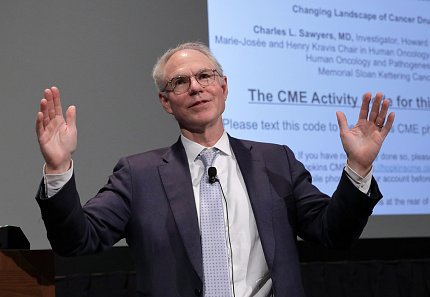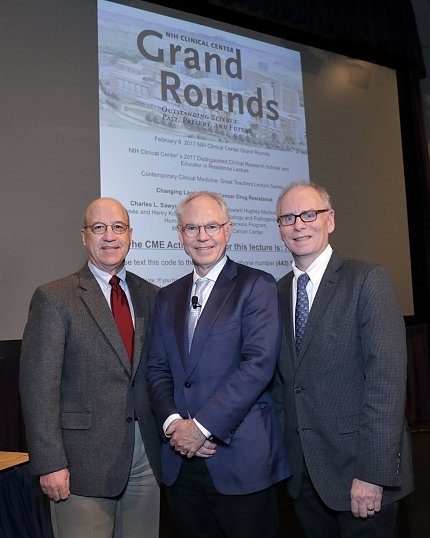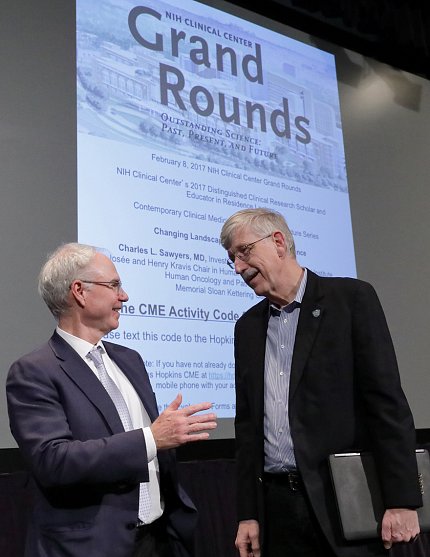Why Remission Fails
‘Great Teacher’ Sawyers Describes Cancer Drug Resistance

Photo: Ernie Branson
Dr. Charles Sawyers has spent much of the last two decades trying to outsmart relentlessly clever and resilient tumor biology. Over the years, he’s used a simple formula with great success: Serendipity plus collaboration mixed with persistence equals remarkable results.
An HHMI investigator since 2002 who currently chairs the Human Oncology and Pathogenesis Program at Memorial Sloan Kettering Cancer Center, he shared other lessons he’s learned recently at a talk in NIH’s Lipsett Amphitheater.
Sawyers delivered “The Changing Landscape of Cancer Drug Resistance,” the Clinical Center’s 2017 Distinguished Clinical Research Scholar and Educator-in-Residence Lecture, a segment in the Contemporary Clinical Medicine Great Teachers series.
Part traditional Grand Rounds, part pep talk for young investigators early in their research careers, the presentation concluded Sawyers’ 2-day visit to NIH, where he met with clinical and lab fellows, medical students and other trainees as well as various senior investigators for state-of-the-science conversations.

Photo: Ernie Branson
“I’ll try to give a lecture that appeals to everybody in the audience, including a lot of prostate cancer experts, who I’ve also met with,” Sawyers said, acknowledging the challenge of tackling in 1 hour a complex topic for attendees at various points along the career spectrum from entry level to advanced. “I’m going to give you a bit of a whirlwind tour, with a little bit of history to go with it.”
Outlining his lecture’s general premise, Sawyers said resistance to targeted therapies can occur by different mechanisms.
He began by tracing his group’s current theories on prostate cancer drug resistance back to 2001 research involving patients experiencing a similar effect using the drug Gleevec (imatinib) to combat chronic myeloid leukemia.
That year, he showed that 95 percent of first-phase CML patients treated with Gleevec experienced a long-lasting remission. About 70 percent of patients with late-stage CML (also called blast crisis CML) went into remission on Gleevec, but the remission lasted only a few months, the 2001 data showed.
Why didn’t remission hold? Sawyers wanted to know. The reason was in the genes—a single mutation in the kinase domain.
Some 15 years ago, his team included a then-grad student in his lab, Mercedes Gorre, and then-clinical fellows Neil Shah and Mike Burgess. Ultimately they revealed “the first explanation for why patients with CML develop resistance to Gleevec,” Sawyers said, pointing out career parallels between his group back then and NIH trainees he recently met—“physicians in medical school who took time out to do research.”
Many of his former trainees now have positions as independent investigators, he reported.
That research team went on to discover that the kinase mutation could occur at not just one site, but several. During the year that followed, Sawyers said, he and his colleagues became dismayed. They were stumped about how to solve the problem.
“Then,” he said, “we serendipitously learned about crystallography work from John Kuryian’s group and formed a collaboration with his team. A eureka moment came as we modeled these [mutation] structures.” Turns out, the mutation interfered with kinase’s ability to form into an optimal shape to bind with Gleevec.
Further proving the organic and synergic nature of medical research, a scientist at the pharmaceutical firm Bristol-Myers Squibb happened to hear a talk Sawyers gave about the crystal models. The pharma investigator contacted Sawyers. A BMS team had a compound—dasatinib—that Sawyers might want to test against the kinase mutations.
In 2009, Sawyers shared the Lasker-DeBakey Clinical Medical Research Award for the work developing imatinib—and later dasatinib, the drug that combats imatinib resistance—as CML therapies.
Fast forward to 2017. Sawyers and his current team are studying prostate cancer treatments. He said he’s often asked: How did you jump from CML to prostate cancer?

Photo: Ernie Branson
“The theme is resistance,” Sawyers answered, “and in this case resistance to hormone therapy.”
Advanced prostate cancer cells feed on androgen hormones, he explained. Treatments to combat the cancer suppress that food source. He and his group co-discovered enzalutamide, an anti-androgen drug approved by the FDA in 2012 to treat metastatic prostate cancer.
But Sawyers’ team also identified several ways tumor cells can adapt to lack of androgen, with determined cells even going so far as to change their biological identities.
The team documented what they called “identity fraud” or “lineage plasticity” after years of collaboration with several other research groups, including the Prostate Cancer Foundation, cBioPortal for Cancer Genomics and a 7-lab consortium affiliated with Stand Up to Cancer’s Dream Team studying prostate cancer. Sawyers’ group published the work in Science in January.
Concluding his lecture, he said he and colleagues now have several questions they’re pursuing: What genotypes are predisposed to reprogram themselves? Does drug treatment speed up the plasticity? What molecular events drive the reprogramming and are there ways to intervene?
Sawyers closed by observing that the cell identity changes his group found in advanced prostate cancer can also translate to other malignancies.
“You could draw a similar analogy with lung cancer treated with EGFR drugs and with BRAF-mutant melanoma,” he said.
Sawyers ended with a public service announcement: Scientists, step up your data-sharing efforts. His and 7 other cancer centers formed a partnership with the American Association for Cancer Research called GENIE, he noted.
“We released data from 19,000 patients sequenced in routine clinical practice, with the idea that we have much to learn and we need large numbers,” he said. “The model by which we convened the 8 centers was a lesson in how to play in the sandbox and how to get institutions and legal departments to work together.”
